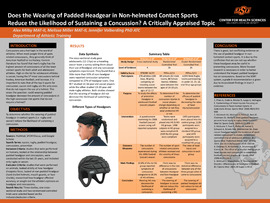| dc.contributor.author | Milby, Alex | |
| dc.contributor.author | Miller, Melissa | |
| dc.contributor.author | Volberding, Jennifer | |
| dc.date.accessioned | 2020-05-05T19:37:51Z | |
| dc.date.available | 2020-05-05T19:37:51Z | |
| dc.date.issued | 2020-02-28 | |
| dc.identifier | ouhd_milby_doesthewearingofpadded_2020 | |
| dc.identifier.citation | Milby, A., Miller, M., & Volberding, J. (2020, Feb. 28). Does the wearing of padded headgear in non-helmeted contact sports reduce the likelihood of sustaining a concussion? A critically appraised topic. Poster presented at Research Day at Oklahoma State University Center for Health Sciences, Tulsa, OK. | |
| dc.identifier.uri | https://hdl.handle.net/11244/324224 | |
| dc.description.abstract | Context: Concussions are a hot topic in the world of athletics. When most people think of concussions in the world of sports, they generally think of sports such as American football or ice hockey. Current literature men's rugby has the highest amount of concussions of all the team contact sports for both adult and adolescent athletes. High on the list for adolescent athletes is soccer, having the 5th most concussions behind hockey, American football, and lacrosse. It is important to note that of the top 5 sports for concussion, soccer and rugby are the only ones that do not require the use of a helmet. This raises the question: could wearing padded headgear decrease the amount of concussions in the high concussion risk sports that do not require a helmet? | |
| dc.description.abstract | Objective: To determine whether or not the wearing of padded headgear in contact sports (i.e. rugby and soccer) reduce the likelihood of sustaining a concussion. | |
| dc.description.abstract | Data Sources: A search was conducted in November 2019. Electronic databases utilized included PubMed, SPORTDiscus, and Google Scholar. Hand searches were also performed through the article's reference lists. The terms used in the search included soccer, rugby, headgear, padded headgear, concussions, and prevention. | |
| dc.description.abstract | Study Selection: Studies were included if performed on humans, looked at the relationship between padded headgear and concussions, were conducted within the last 15 years, and included only rugby or soccer. Studies were excluded if they were performed on animals, looked strictly at how headgear dissipates force, looked at non-padded headgear (hard shelled helmets, mouth-guards, or face shields), researched how headgear effected accuracy, or sought out the athlete's opinions on headgear and concussions. | |
| dc.description.abstract | Data Extraction: Three studies, one cross-sectional study and two randomized controlled trials were selected based on the inclusion/exclusion criteria. Data Synthesis: The cross-sectional study asked adolescents (12-17yo) on a traveling soccer team a survey that asked them about their use of headgear and any concussion symptoms experienced and found that a little more than 50% of non-headgear users reported concussion symptoms compared to 27% of headgear users. One RCT studied 14-18-year-old soccer players while the other studied 13-20-year-old male rugby athletes. Both studies showed that the wearing of headgear did not decrease the likelihood of sustaining a concussion. | |
| dc.description.abstract | Conclusions: There is good, but conflicting evidence about the use of padded headgear in non-helmeted contact sports. It is due to this confliction that we cannot say whether or not these headgears may be useful in preventing concussions. More focused research is necessary in order to better understand the impact padded headgear has on concussions. Based on the SORT system, a grade B recommendation is given due to inconsistent findings in level 2 evidence. | |
| dc.format | application/pdf | |
| dc.language | en_US | |
| dc.publisher | Oklahoma State University Center for Health Services | |
| dc.rights | The author(s) retain the copyright of have the right to deposit the item giving the Oklahoma State University Library a limited, non-exclusive right to share this material in its institutional repository. Contact Digital Resources and Discovery Services at lib-dis@okstate.edu or 405-744-9161 for the permission policy on the use, reproduction or distribution of this material. | |
| dc.title | Does the wearing of padded headgear in non-helmeted contact sports reduce the likelihood of sustaining a concussion? A critically appraised topic | |
| osu.filename | ouhd_milby_doesthewearingofpadded_2020.pdf | |
| dc.type.genre | Presentation | |
| dc.type.material | Text | |
| dc.subject.keywords | headgear | |
| dc.subject.keywords | concussion | |
| dc.subject.keywords | prevention | |
| dc.subject.keywords | contact sports | |
